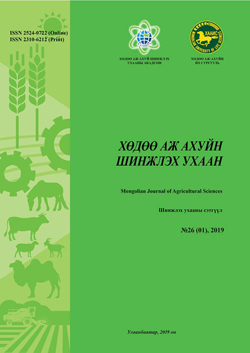Seed viability of some species of stipa l
DOI:
https://doi.org/10.5564/mjas.v26i01.1198Keywords:
genebank, field germination, winter survive, viabilityAbstract
In territory of Mongolia growing the 17 species of Stipa type. The more than 3000 samples of 190 species of 46 types of perennial plants stored stored in Forage perennial plant’s Genebank of Research Institute of Animal Husbandry, Mongolia, including more 100 samples of 7 species of Stipa. In recent time necessary to study the seed viability of Stipa species and increase, enrich and renew the seed resources in genebank. We studied the seed viability of needle grass (Stipa L) species, that are collected between 1994-2014from the territory of Mongolia. During the identification of lab germination the samples stored for 24 years did not germinated and 27.2% of samples stored for 20-22 years had only 0.4-8.0% of the germination. Whereas, the samples stored for 15-16 years are germinated in 24.0-96.0%, and samples stored for 4-9 years are 56.5-100.0%, and this results shown that the seed germination rate are depending from the stored years. During the field experiment the 11 samples of 3 species of Stipa were tested in irrigated areas and 13.6-72.7% of them were germinated, 50-100% of them survived to autumn and 83.3-100% of them survived for first winter. From our studies, the needle grass samples are quite good at surviving the winter-spring hardships and the vitality of the already-proven plant survival in the second year of life has increased.
Хялгана (stipa l.)-ын төрлийн зарим зүйл ургамлын үрийн амьдрах чадвар
Хураангуй: МААЭШХ-ийн Тэжээлийн олон наст ургамлын генофондод хадгалагдаж буй Хялгана (Stipa L) – ы төрлийн ургамлын үрийн амьдрах чадварыг судаллаа. Лабораторийн судалгааны явцад генофондод 24 жил хадгалагдсан дээжүүд огт соёолсонгүй, 20-22 жил хадгалагдсан дээжүүдийн 27.2% нь дөнгөж 0,4-8.0%-ийн соёололттой байлаа. Харин 15-16 жил хадгалагдсан дээжүүд 24.0-96.0%, 4-9 жил хадгалагдсан дээжүүд 56.5-100.0%-ийн соёололттой байгаагаас үзэхэд үрийн соёолох чадвар хадгалах хугацаанаас ихээхэн хамаарч (P≤0.001) байна. Хээрийн судалгаагаар Хялгана (Stipa L) – ы төрлийн 3 зүйлийн 11 дээжийг 2017 онд усалгаатай нөхцөлд тарьж туршихад 13.6-72.7%-ийн хээрийн соёололттой байсан бөгөөд амьдралын 2 дахь жилийн хавар 50-100% нь сэргэн ургаж, 83.3-100%-ийн амьдрах чадвартай байв. Бидний судалгаанаас Stipa -ийн төрлийн дээжүүд өвөл - хаврын хатуу ширүүн нөхцлийг даван туулж амьдралын эхний жилийн өвлийг давах чадвар нилээд сайн, амьдралын 2 дахь жилээс нэгэнт биежсэн ургамлын амьдрах чадвар нэмэгдэж байна.
Түлхүүр үг: Генофонд, хээрийн соёололт, өвөлжилт, амьдрах чадвар
Downloads
714
Downloads
Published
How to Cite
Issue
Section
License
Copyright on any research article in the Mongolian Journal of Agricultural Sciences is retained by the author(s).
The authors grant the Mongolian Journal of Agricultural Sciences a license to publish the article and identify itself as the original publisher.

Articles in the Mongolian Journal of Agricultural Sciences are Open Access articles published under a Creative Commons Attribution 4.0 International License CC BY.
This license permits use, distribution and reproduction in any medium, provided the original work is properly cited.




